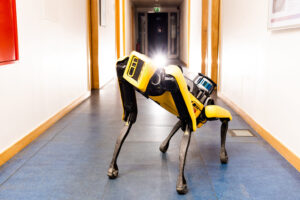The project at a glance
-
Start date:01 Nov 2020
-
Duration in months:36
-
Funding:Stugalux
-
Principal Investigator(s):Holger Voos
About
Stugalux, a construction company based in Luxembourg, and the Automation and Robotics research group at SnT entered into a three-year research partnership to extend the navigation capabilities of the Boston Dynamics Spot robot for autonomous 3D information collection of construction sites.
Stugalux was one of the first construction companies in Europe to acquire the Boston Dynamics Spot robot to monitor their construction sites. The robot is equipped with laser scanners and cameras to acquire precise data that can be used by construction engineers. While being a very powerful robotic platform, capable of walking over rough construction surfaces, climbing up and down stairs, and detecting and avoiding obstacles that are on its way, the robot still requires a human to teleoperate it from its remote controller.
The goal of the partnership is to provide the robot with the capability to navigate autonomously without the need for a human operator. This will allow the robot to navigate on its own onto any of Stugalux’s 200 sites in Luxembourg, while avoiding interference with the construction works, to regularly acquire the data that construction engineers use to check the progression of developments according to the project specifications, allowing them to take corrective actions at an early stage, minimizing the deviations and thus saving money and time.
Our research focuses on the enhancement of the situational awareness of the robot. The robot must be able to build a map of the construction site and localize within it, relying on the measurements of its onboard sensors. This map includes not only geometric information (e.g. 3D point cloud) but also higher-level semantic-topological abstractions (e.g. walls, rooms, floors), not only to enhance the accuracy of its situational awareness, but also to enable intelligent decision-making and autonomous task execution, and to facilitate human-robot interaction. Moreover, the robot must be able to read and understand the available digital plans of the construction site and localize within it, being able to make the distinction between the as-planned and the as-built maps.
The ARG team includes Muhammad SHAHEER, a doctoral candidate; Dr. Hriday BAVLE, a research associate, and Dr. Jose-Luis SANCHEZ-LOPEZ, a research scientist. They are led by Prof. Holger Voos – head of the Automation and Robotics research group.
There are a series of research projects that complement this partnership by investigating other aspects of the situational awareness of mobile robots, as well as, investigating how to exploit the multi-abstraction situational awareness in intelligent decision-making and autonomous task execution:
• IAS Audacity TRASCEND
• FNR CORE 5GSky
• FNR CORE DEUS
• FNR AFR RoboSAUR
• FNR AFR MOCCA
• H2020 SESAME
Organisation and Partners
- Automation & Robotics Research Group
- Interdisciplinary Centre for Security, Reliability and Trust (SnT)
- Stugalux
Project team
-
Holger Voos
-
Jose-Luis Sanchez-Lopez
-
Hriday Bavle
-
Muhammad SHAHEER
Keywords
- Robotics
- Robot
- Mobile Robot
- Boston Dynamics Spot
- Autonomous Navigation
- Situational Awareness
- Simultaneous Localization and Mapping (SLAM)
- Digital twin
- Construction
- Robots for construction
